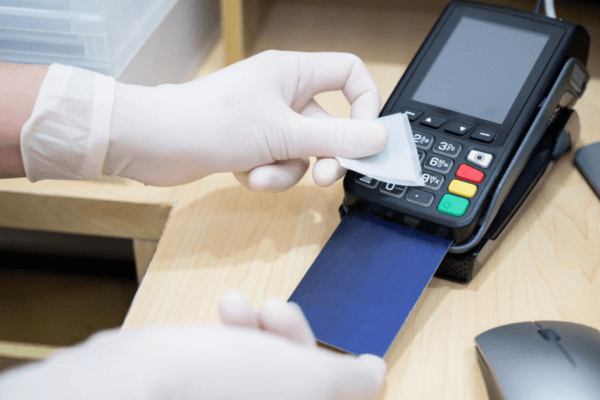
Apesar de fiável e seguro, um automatic payment terminal (TPA), tal como acontece com qualquer outro mecanismo, necessita de cuidados de manutenção e limpeza.
Independentemente de possuir ou não a funcionalidade contactless (meio de pagamento mais utilizado na rede de retalhistas REDUNIQ), para que o seu TPA dure mais tempo, tome nota das dicas e conselhos de limpeza que temos para si.
Como limpar e desinfectar o seu TPA?
A melhor forma de aumentar a longevidade de qualquer mecanismo é, sem sombra de dúvidas, mantê-lo sempre limpo.
One TPA, como o REDUNIQ Easy or the REDUNIQ Smart, é um mecanismo tecnológico de alta precisão constituído por dezenas de partes extremamente delicadas, como é o caso do teclado.
Quando poeiras ou sujidade se infiltram pelas ranhuras do teclado, isto pode gerar problemas no funcionamento do terminal e, até, fazer com que este deixe de operar.
De igual modo, quando um seu cliente introduz o um credit card ou cartão de débito com sujidade na ranhura do TPA, este último pode sentir dificuldades na leitura do mesmo.
Para que nada disto se verifique, eis como deve fazer, passo a passo, a limpeza do seu terminal de pagamento automático.
Ler as instruções do fabricante antes de iniciar a limpeza
Antes de dar inicio à limpeza do seu TPA, leia as instruções do fabricante, uma vez que a utilização de determinados produtos podem danificar o equipamento e levar à perda da garantia.
Verificar se o TPA se encontra ligado à tomada
Se o TPA está ligado à corrente, desligue-o para evitar curtos-circuitos.
Comece por limpar o exterior
Com os dois passos anteriores cumpridos, comece a limpeza do TPA pelo seu exterior utilizando, para o efeito, um pano húmido.
Dedique mais tempo à limpeza das áreas junto às teclas e nas zonas laterais do terminal, já que são nestes pontos em que, por norma, os clientes têm maior tendência para tocarem.
Utilize o cartão de limpeza
Depois da limpeza e higienização da parte exterior do TPA, é altura de utilizar um cartão de limpeza específico para as ranhuras de leitura de cartões. Tome atenção às instruções do fabricante.
Ligue o TPA
Lave as mãos e, de seguida, ligue o TPA novamente.
Dicas para manter o seu TPA como novo
Se se está a interrogar com que regularidade deve limpar o TPA, tudo irá depender da utilização que dá ao terminal, a época do ano em que se encontra (primavera e verão são alturas mais propicias à acumulação de ácaros e sujidade, por exemplo) e se recebe mais pagamentos por PIN ou contactless (no caso do contactless, o cartão ou smartphone do cliente não entra em contacto com o TPA).
Caso tenha uma alta taxa de utilização e se encontra numa estação do ano em que proliferam as poeiras, o TPA deve ser limpo regularmente.
Já se não utilizar o TPA com frequência e este se encontrar protegido (dentro de uma gaveta, por exemplo), pode apenas higienizá-lo de forma anual.
Dito isto, caso o terminal se suje, deve limpá-lo imediatamente. Eis algumas dicas a respeito de limpeza e higienização:
Limpeza geral
A limpeza deve ser realizada com um pano macio embebido numa solução à base de água e sabão ou algumas gotas de detergente da louça em água morna.
Neste particular, os panos microfibra são os mais indicados, apesar de panos sem fibras soltas também possam ser utilizados. Nas zonas mais sensíveis do TPA, procure utilizar um pano seco.
Higienização/Desinfeção
Para a higienizar ou desinfetar o seu terminal, opte por utilizar toalhitas desinfetantes descartáveis especificas para aparelhos eletrónicos ou, em alternativa, um pano macio com um desinfetante específico para a tarefa.
Limpar a ranhura do cartão
Como já referimos, para limpar a ranhura do terminal, utilize sempre um cartão de limpeza (produto especifico para a limpeza das ranhuras de leitura).
Exposição
Evite expor as zonas mais sensíveis do TPA (ranhura de leitura, partes de acesso ao interior do terminal e o espaço entre as teclas) à humidade.
Regras de Higiene do TPA: o que não deve fazer
Como já fomos revelando ao longo deste artigo, há coisas que nunca deve fazer para manter o TPA higiénico e limpo, tais como:
- Nunca borrifar as soluções de limpeza diretamente no TPA;
- Não utilizar um pano demasiadamente húmido que possa deixar gotas na superfície do terminal;
- Não utilizar álcool ou soluções à base de álcool na higienização das partes mais sensíveis do TPA, já que os terminais com tecnologia sensível ao toque vêm equipados com uma película protetora que pode ser danificada por esse tipo de produtos.


